| Day |
Plan |
Overnight |
| Day 1 |
Land in Vienna and visit the famous palaces |
Vienna |
|
Day 1
|
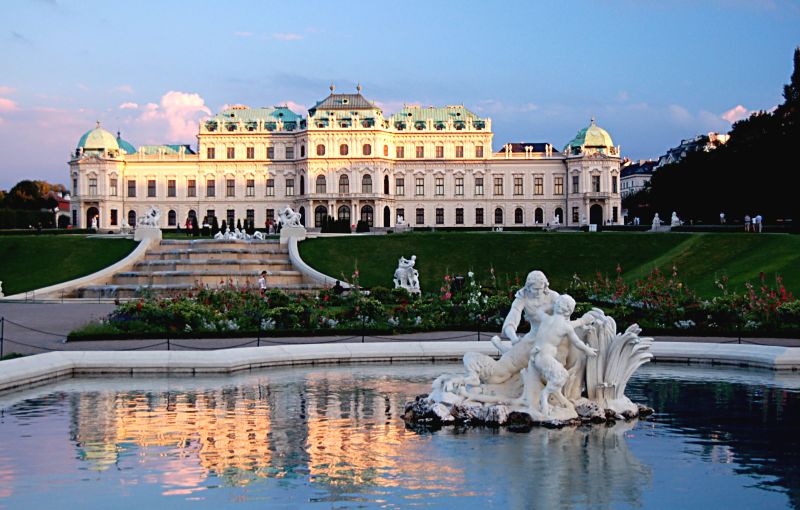
On arrival, head to your accommodation in Vienna, freshen up and head to visiting the famous palaces in the city. Austria's Imperial capital offers a unique blend of imperial traditions and stunning modern architecture. It is famous for its cultural events, imperial sights, coffee houses, cozy wine taverns, and the very special Viennese charm.
Schloss Schönbrunn, the former imperial summer residence, is one of the most popular sights. The sumptuous palace with beautifully tended formal gardens, the Gloriette monument, the Palm House, and the zoo attract many visitors each year. The imposing Hofburg (Imperial Palace) was the base of the Habsburgs for over six centuries, and is an impressive repository of culture and heritage.
The splendid baroque Belvedere Palace today houses the Österreichische Galerie (Austrian Gallery) displaying the largest collection of works by Klimt (The Kiss) and Kokoschka as well as famous paintings by Schiele.
|
|
| Day 2 |
Visit the cathedrals and other landmark sights of Vienna |
Vienna |
|
Day 2
|

This list includes: Vienna City Hall (Rathaus), St. Stephen's Cathedral, The Famous Demel, Sigmund Freud Museum
Vienna City Hall (Wiener Rathaus) - Vienna City Hall is Vienna's most important non-religious building in the Neo-Gothic style. It is the official seat of the Mayor and the meeting place of the city senate/provincial government and the Municipal Council/Landtag.
St Stephen's Cathedral - The magnificent Gothic edifice that is St Stephen’s Cathedral, the mother church of the Roman Catholic Archdiocese of Vienna, is one of Vienna’s most culturally significant landmarks. It’s also an important heritage site, and is respected across Austria and indeed throughout the world.
The famous Demel - Demel (colloquially der Demel) is a famous pastry shop and chocolaterie established in 1786 in Vienna, Austria. The company bears the title of a Purveyor to the Imperial and Royal Court (k.u.k. Hofzuckerbäcker) up to today.
Sigmund Freud Museum - The Sigmund Freud Museum in Vienna is a museum founded in 1971 covering Sigmund Freud's life story. It is located in the Alsergrund district, at Berggasse 19. In 2003 the museum was put in the hands of the newly established Sigmund Freud Foundation, which has since received the entire building as an endowment. Wikipedia
|
|
| Day 3 |
Spend an easy day strolling through the streets of magnificent Vienna |
Vienna |
|
Day 3
|
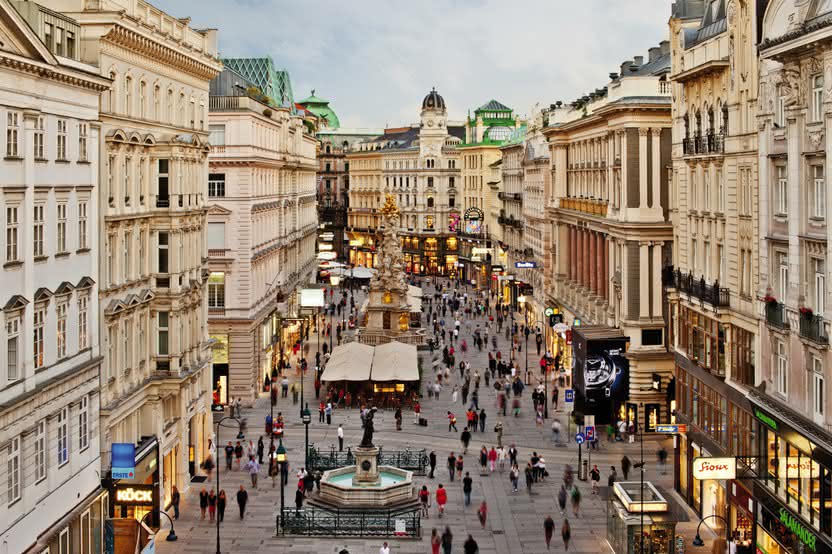
A leisurely day, walk through the cobblestoned streets of Vienna, visit the Giant Ferris Wheel in the Prater, Kunsthistorisches Museum Vienna with the world’s largest collection of Bruegel paintings, MuseumsQuartier with the Leopold Museum (Schiele), Museum Moderner Kunst (Museum of Modern Art), Haus der Musik, is a modern interactive experimental museum in the history city centre of Vienna, also where the Philharmonic was founded.
Check out traditional coffee houses, rustic wine taverns, and the beloved sausage stand (Wuerstelstand) exist alongside top restaurants and shops.
|
|
| Day 4 |
Drive along the Danube towards Salzburg |
Salzburg |
|
Day 4
|

Check out from your accommodation in Vienna and drive along the Danube river towards Salzburg. En route, stop at Durnstein and Melk Abbey
The city of Dürnstein and the ruin of Dürnstein Castle are connected by a wall. The castle was built between 1140-1145 by the family Kuenring (Hadmar I), and in 1645 it was demolished by a blast carried out by the Swedes under General Torstenson. A model of the city and the ruin are on display at Dürnstein Abbey. The trail that was created around the ruin of Dürnstein will lead you through some of the most beautiful natural and cultural scenic outlook points in the region of the Wachau.
When the rising sun illuminates Melk Abbey, a colossal and wonderfully beautiful monument is brought to life. Melk Abbey is the symbol of the Wachau Valley and its steep, terraced vineyards overlooking the Danube. The abbey contains the tomb of Saint Coloman of Stockerau and the remains of several members of the House of Babenberg, Austria's first ruling dynasty.
Arrive in Salzburg by late evening and check in to your accommodation
|
|
| Day 5 |
Day one of visiting the landmark spots of Salzburg |
Salzburg |
|
Day 5
|
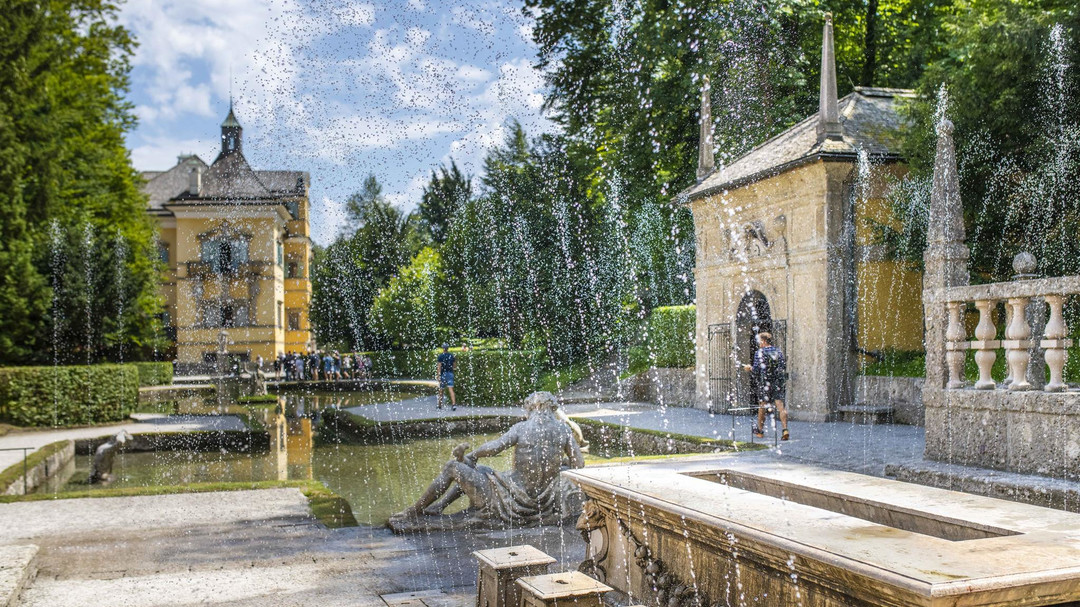
Salzburg, often called the "Stage of the World", have a lot packed into the compact city. Visit Fortress Hohensalzburg, St. Peter's Church, Salzburg Cathedral, Hellbrunn Palace and Fountains today.
St Peter’s Abbey is not just the oldest church or monastery in Salzburg, but one of the oldest in Europe. Founded in 686 by St Rupert (Patron Saint of Salzburg), St Peter’s Abbey is located in the oldest quarter of the city.
Hohensalzburg Fortress is enthroned on the Festungsberg, high above the rooftops of the Baroque historical district. The biggest fully preserved castle in Central Europe, this emblem of Salzburg offers a 360-degree view of the city and its surroundings.
Of its numerous churches, the cathedral is Salzburg's most important sacred building. With its mighty dome and two towers, it leaves its own distinctive, and absolutely impressive stamp on the city skyline. A closer look at the cathedral reveals many surprising and exciting details. Saint Rupert founded the church in 774 on the remnants of a Roman town, and the cathedral was rebuilt in 1181 after a fire.
Hellbrunn Palace is an early Baroque villa of palatial size, near Morzg, a southern district of the city of Salzburg, Austria. It was built in 1613–19 by Markus Sittikus von Hohenems, Prince-Archbishop of Salzburg, and named for the "clear spring" that supplied it. You never know what to expect in Hellbrunn. Only one thing is certain - it is a lot of fun. The trick fountains spray water from all nozzles and spouts, but no worries - guests might catch a few drops, but certainly won’t get drenched! This amusement is enjoyed by visitors from all over the world. But Hellbrunn is more than just its unique trick fountains. The palace and the surrounding park areas are places for celebration, for pleasure and recuperation. Just like Prince-Archbishop Markus Sittikus intended.
|
|
| Day 6 |
Day two of Salzburg's landmark sights and a stroll around Altstadt |
Salzburg |
|
Day 6
|
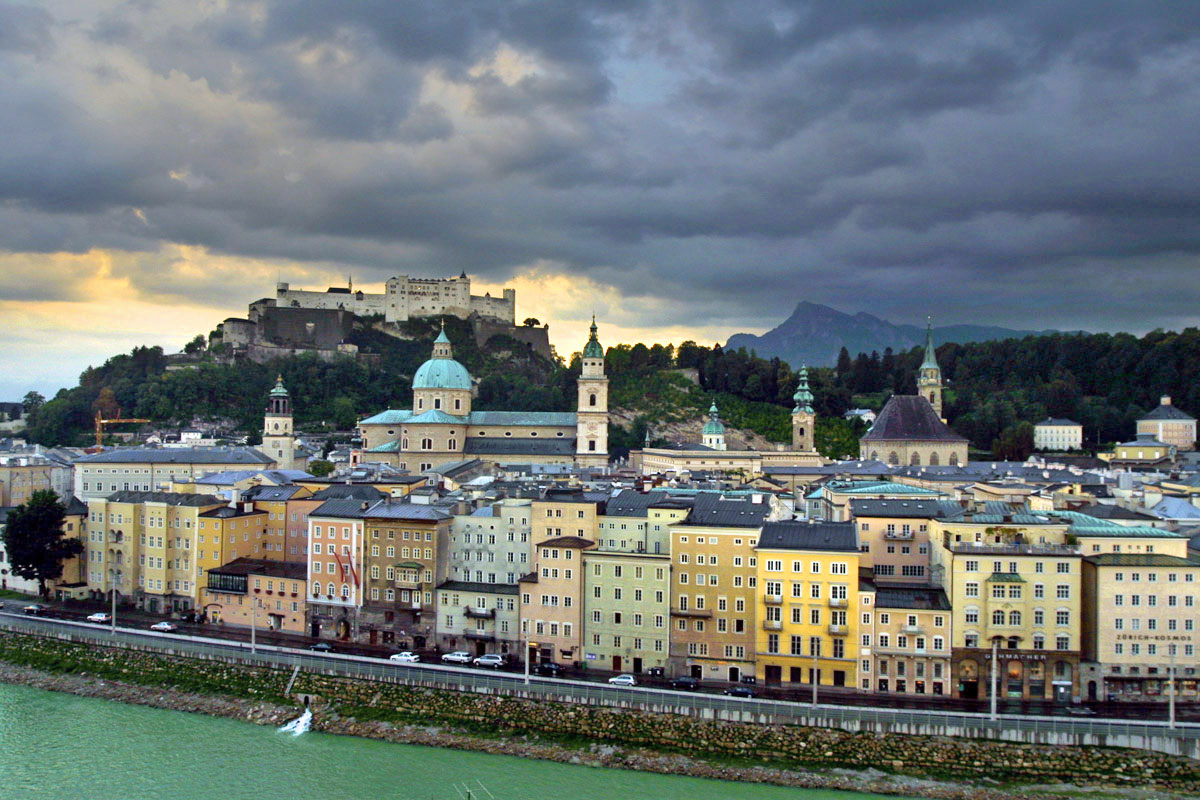
Visit Mirabell Palace and Gardens, Mozart's Birthplace, Hallein and the Celtic Museum first and then head towards Altstadt.
Mirabell Palace was built in 1606 by prince-archbishop Wolf Dietrich for his beloved Salome Alt. Today, it serves as the backdrop for the most romantic weddings you could possibly imagine. Mirabell is a woman’s name from Italy, a compilation of two words: mirabile "admirable" and bella "beautiful".
The Marble Hall, the former banquet hall of the prince-archbishops, is generally regarded as one of the "most beautiful wedding halls in the world". In former times, the likes of Leopold Mozart and his children, Wolfgang and Nannerl, made music here. The Mirabell Gardens were completely redesigned under archbishop Johann Ernst von Thun in 1690. The underlying geometrical form, which is typical for the Baroque period, is still clearly recognizable. The visual orientation towards the cathedral and fortress adds to the grandeur of the gardens – simultaneously incorporating them into the overall historical ensemble of the city.
Mozart's birthplace was the birthplace of Wolfgang Amadeus Mozart at No. 9 Getreidegasse in Salzburg, Austria. The Mozart family resided on the third floor from 1747 to 1773. Mozart himself was born here on 27 January 1756. He was the seventh child of Leopold Mozart, who was a musician of the Salzburg Royal Chamber
The Museum of the Celts in Hallein is one of the largest museums for Celtic history and art in Europe. Other aspects of the past that come to life here as well are the prehistory of Salzburg and the urban history of Hallein. The combination of Ice Age burial grounds, settlement areas and salt mining on Dürrnberg is unique in Europe. Walk-in mining galleries, views into burial chambers, artistic gold jewellery – art and culture of the Celts can be experienced in close-up in Hallein. The absolute highlight: the beak-spouted Dürrnberg Jug, 2,500 years old, with its fabulous predatory beasts and demons. A separate exhibition on the ground floor transports visitors on a time trip to the prehistory of Salzburg. Moreover, three archiepiscopal royal rooms from 1756/57 are on show, together with objects illustrating the history of Hallein and the historical salt industry.
The Altstadt Salzburg is a district of Salzburg, Austria, recognised as UNESCO World Heritage Site since 1996. It corresponds with the historic city centre, situated on the left and right banks of the Salzach river.
|
|
| Day 7 |
Head to Hallstatt, stopping at Wolfgangsee and Mondsee en route |
Hallstatt |
|
Day 7
|
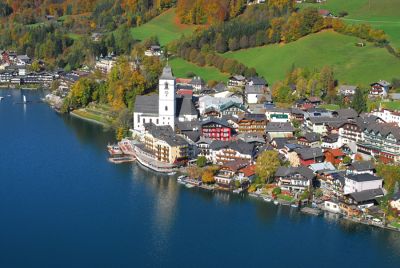
On your way to Hallstatt, make a stop at Lake Wolfgang or Wolfgangsee. The towns of St. Gilgen, Strobl and St. Wolfgang all share this lake in Upper Austria and Salzburg. The lake is impressively framed by the Schafberg, the 12er Horn and the Postalm. Whether it’s hiking, cycling or water sports in summer, or cross-country skiing, downhill skiing and hut romance in winter – you choose. A packed calendar of events on water, land and in the air make Lake Wolfgang an attractive destination at any time of the year.
Then proceed to Mondsee
Mondsee is a scenic Upper Austrian town at the northern banks of Mondsee Lake and is named for the lake’s crescent-moon shape. Come to Mondsee to enjoy the “pearl in the Salzkammergut” and experience the lake’s breathtaking scenery as well as fishing, sailing, swimming and fine dining.
Explore Mondsee town to learn about the region’s fascinating history. Mondsee is home to a series of Neolithic pile dwellings, or stilt houses, that date back 5,000 years and are heritage-listed by UNESCO. Stop by the Basilica of St. Michael Collegiate Church to see the cloister church that hosted the wedding in the famous 1965 Austrian-set film The Sound of Music.
Plan to arrive at Hallstatt by evening. Check in to your accommodation and spend rest of the evening at leisure
|
|
| Day 8 |
Discovering Hallstatt |
Hallstatt |
|
Day 8
|
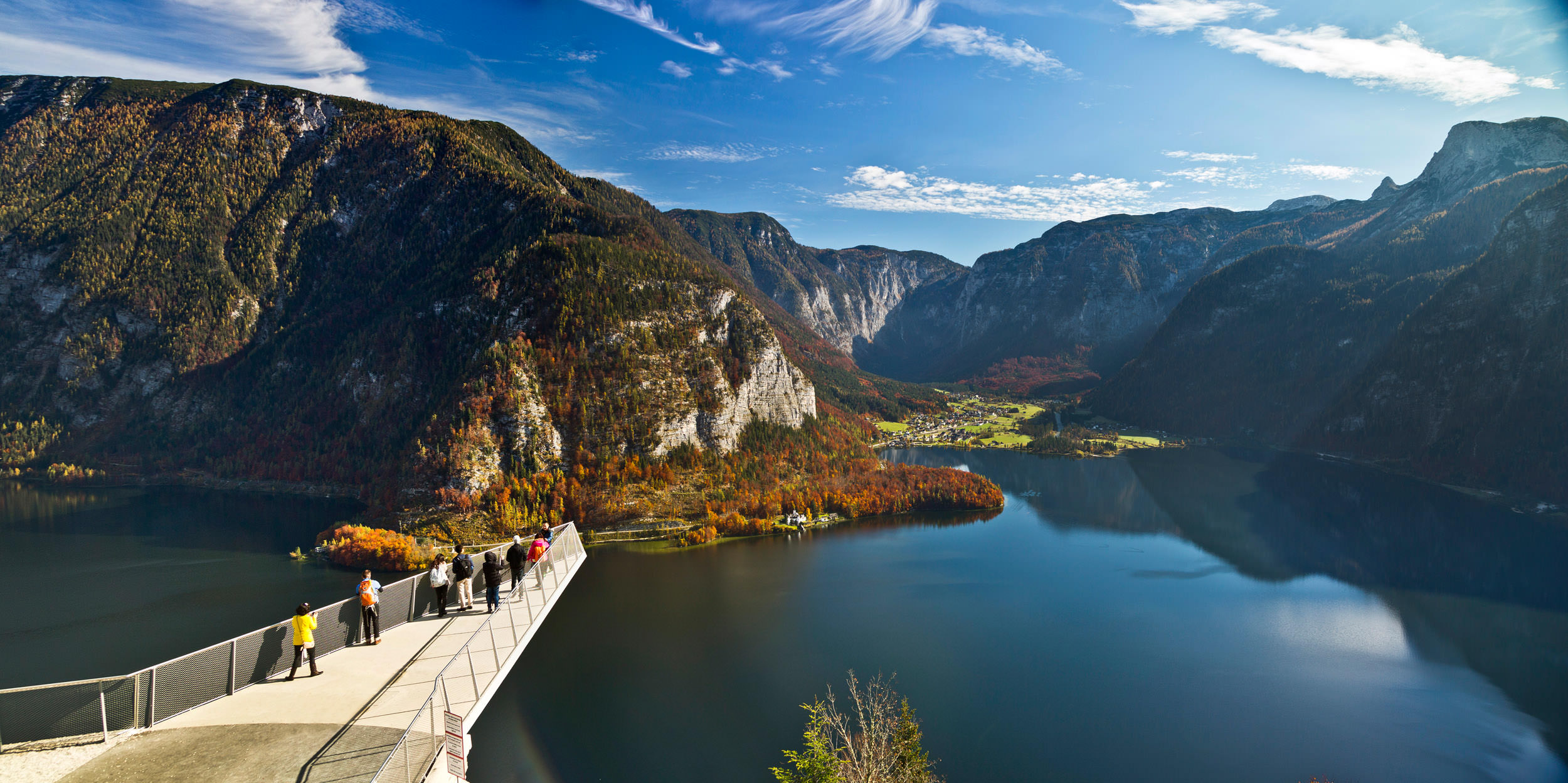
With pastel-coloured houses casting shimmering reflections onto the looking-glass lake and with lofty mountains rearing up on all sides, Hallstatt’s beauty borders on the surreal and the sublime.
Visit: Hallstatt Salt Mine, Hallstatt Skywalk, Dachstein Mountains and the Five Fingers, Dachstein Caves
The oldest salt mine in the world, Europe’s oldest wooden staircase and the free-floating Skywalk with its “World Heritage View”, 360 meters above the ground: Hallstatt Salt Mine is a mine of superlatives. Go on a journey of discovery, back to the very beginnings of salt mining some 7,000 years ago, and experience the history of Bronze Age mining, recounted today in spectacular fashion thanks to state-of-the-art multimedia technology, including a Bronze Age Cinema 400 meters below ground. Here, you will experience up-close the very breath of history.
5fingers viewing platform
This visitor attraction opened at the beginning of October, 2006. Also known as the "World Heritage View Point". Built 500 metres above ground, the viewing platform is in the shape of a hand with 5 fingers, and protrudes from a sheer rock face. Affording stunning panoramic views of the World Heritage Region, this has become a number 1 attraction in the Dachstein/Krippenstein Region. The Five fingers Viewing Platform is a pleasant 15 minute walk from the Dachstein Krippenstein cable car summit station.
Dachstein Giant Ice Cave in Obertraun on foot of the Krippenstein, these magnificent giant ice palaces rank among the greatest natural wonders of the Alps. People come from all over the world come to admire these subterranean Dachstein ice caves.
Gigantic cave glaciers, vast icebergs, frozen cascades of blue-coloured ice and "ice chapels" are just some of the highlights of your tour. These caves are the perfect refuge for humans and animals on cold, rainy days - just as they have been for thousands of years - and on a hot summer's day they are a welcome contrast to the outside world.
|
|
| Day 9 |
Drive to Zell am See, stopping at Bad Gastein en route |
Zell am See |
|
Day 9
|

Check out from Hallstatt and proceed to drive towards Zell am See, stopping at Bad Gastein on the way.
Bad Gastein is an Austrian spa and ski town in the High Tauern mountains south of Salzburg. It’s known for the belle epoque hotels and villas built on its steep, forested slopes. The Wasserfallweg is a path offering views of the town’s central Gasteiner Waterfall plummeting to the valley floor. Gothic frescoes adorn St. Nicholas Church. The Gasteiner Museum chronicles the town's thermal springs and notable guests.
Plan to arrive in Zell am See by evening. Check in to your accommodation and spend rest of the evening at leisure
|
|
| Day 10 |
Grossglockner Day trip |
Zell am See |
|
Day 10
|

The high mountains and the Grossglockner: What was once reserved for experienced mountaineers only, has been an experience for young and old since the construction of the Grossglockner High Alpine Road, which enjoys unbroken enthusiasm and fascination. Much has changed since the opening of the Alpine Road in 1935. The road became wider, safer and more comfortable. Exhibitions and museums, huts and mountain inns, visitor centres and information points focus on the diverse mountain world with its fauna and flora in the middle of the Hohe Tauern National Park. The mountain road blends harmoniously into the landscape, offers a unique mountain experience - and for more than 80 years has provided 48 kilometres of incomparable driving pleasure.
The Grossglockner High Alpine Road is the highest surfaced mountain pass road in Austria. It connects Bruck in the state of Salzburg with Heiligenblut in Carinthia via Fuscher Törl and Hochtor Pass at 2,504 m. The road is named after the Grossglockner, Austria's highest mountain
Visit Heiligenblut. The legendary mountain climber village of Heiligenblut is regarded as probably one of the most beautiful in the entire Alpine region. It is set in a picturesque mountain landscape at almost 1,300 metres above sea level, against a unique natural backdrop in the Hohe Tauern National Park, watched over by the mighty summit of the Grossglockner.
On the way back, stop at the Tauern Spa Hotel
|
|
| Day 11 |
Day trip to Kitzsteinhorn |
Zell am See |
|
Day 11
|
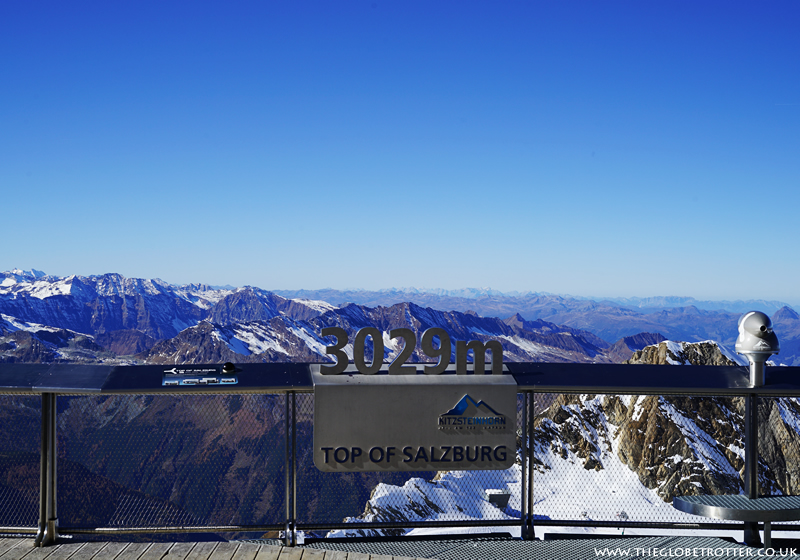
The Kitzsteinhorn, as impressive, distinctive peak in the Hohe Tauern, dominates the appearance of the Zell am See-Kaprun region. As the only 3.000 metres high mountain in the Salzburger Land, it offers access to the alpine adventure world of the alpine mountains all year round. Top-modern mountain railways and a top-infrastructure take visitors and holidaymakers safely and comfortably uphill to over 3.000 m above sea level 365 days a year. What started as an extraordinary pioneering achievement 50 years ago continues now in Salzburg‘s only glacier ski resort. The Kitzsteinhorn is known for its unique, alpine mountain adventure not only in winter. Gipfelwelt 3000 with TOP OF SALZBURG and Salzburg‘s highest-situated panorama platform, accessible to everyone, create unparalleled holiday impressions.
|
|
| Day 12 |
Head to Kitzbuhel |
Kitzbuhel |
|
Day 12
|

Drive to Kitzbuhel and check in and proceed to explore the town.
Kitzbühel is a small Alpine town east of Innsbruck, in the western Austrian province of Tyrol. It's a fashionable winter resort, known for the annual Hahnenkamm downhill race. Upscale shops and cafes line the streets of its medieval center. Museum Kitzbühel chronicles the history of the town and the area’s winter sports, with paintings by local artist Alfons Walde. Its rooftop terrace has sweeping town views.
Visit The Hahnenkamm - a mountain directly southwest of Kitzbühel in the Kitzbühel Alps of Austria. The elevation of its summit is 1,712 metres above sea level. The Hahnenkamm is part of the ski resort of Kitzbühel, and hosts an annual World Cup alpine ski race, the Hahnenkammrennen.
Also visit the Alpine Flower Garden.
|
|
| Day 13 |
Visit Kitzbuheler Horn and The Schwarzsee Lake |
Kitzbuhel |
|
Day 13
|
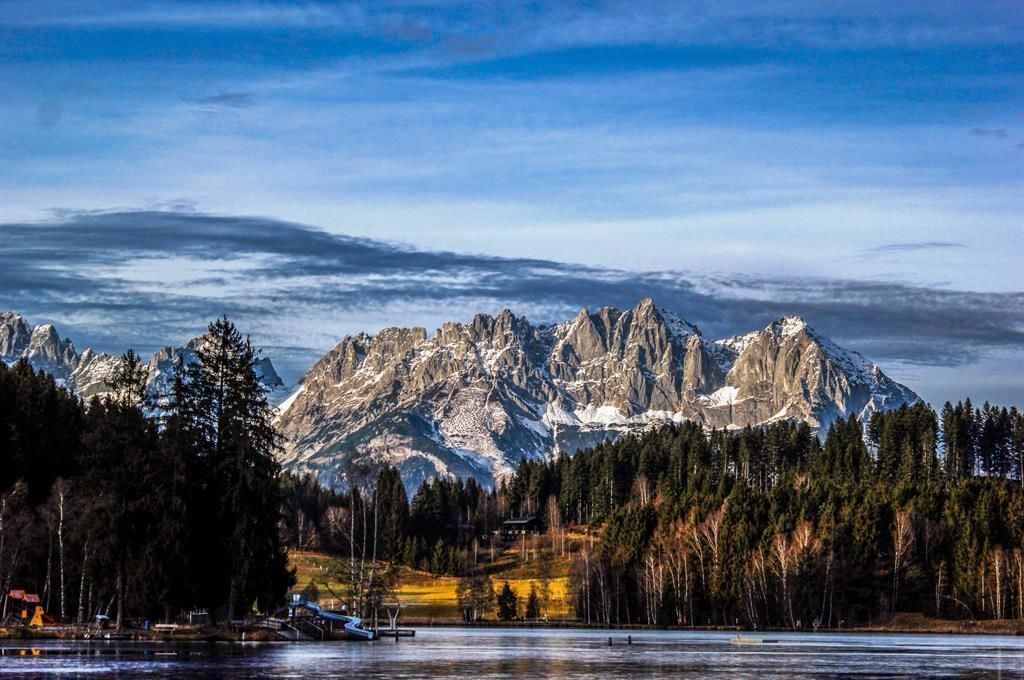
The Kitzbüheler Horn (also spelt Kitzbühler Horn) is a mountain in the Kitzbühel Alps in Tyrol, Austria, whose eastern flank lies near the smart ski resort of Kitzbühel. The mountain has several cable cars and gondola lifts and there is a panoramic toll road from Kitzbühel. There are also several mountain inns on its slopes. Numerous lifts have been built to support winter sports in the ski region of the same name. On the side facing St. Johann there is a mountain cart route. There is a small mountain lake level with the half-way station on the cable car from the village. Both peaks are heavily frequented, not just by hikers, but also by mountain bikers due to its good paths.
Kitzbühel has got much more to offer than the "Streif" ski slope, a well-known tennis competition and the Kitzbüheler Horn. n the surroundings there is also Lake Schwarzsee, which is a moor lake situated some 2 km in the west of Kitzbühel along the Brixental Road in the heart of the Kitzbühel Alps. Via this road and the station of the Salzburg-Tyrol railway the lake is easily accessible.
The lake might not be that popular, but is considered to be one of the most beautiful and warmest lakes for bathing in the Alps. Not only due to its pleasant water temperature the lake made it's mark. It is really perfect to enjoy a swim as well as the fantastic world of mountains in the surroundings, including the Wilder Kaiser mountain chain with its peaks which are higher than 2,000 metres. This impressive landscape encircles the lake, which is just 10 metres deep, and forms the backdrop for the walking trail. The black water is immediately obvious. According to legend, the water of the Sense Oberland mountain lake is as dark as it is because a giant bathed its feet in it one day. A special attraction along the lake path is the "Schwarzsee Dragon", created from iron an sheet metal by a local artistic blacksmith. This popular photo subject is part of the Witch Path, a thematic hiking trail with local fables and tales for children and the ever-young.
|
|
| Day 14 |
Head to Innsbruck via Krimml Falls and Swarovski Kristallwelten |
Innsbruck |
|
Day 14
|

Drive to Innsbruck, stopping at Krimml Falls and Swarovski Kristallwelten on the way.
The Krimml Waterfalls, with a total height of 380 metres, are the highest waterfall in Austria and Europe. The falls are on the Krimmler Ache river and are located near the village of Krimml in the High Tauern National Park.
The Swarovski Crystal Worlds is an experience attraction created by André Heller for the crystal glass manufacturer Swarovski, consisting of a park, art museum, retail area, and restaurant.
Plan to arrive in Innsbruck by evening. Nestled amidst majestic peaks, this breathtaking city offers a unique combination of nature, history, and culture. You can stroll its streets full of Baroque and Gothic architecture in the Old Town, or discover one of the hip districts such as Mariahilf or St. Nikolaus where Innsbruck’s uni students like to meet for a drink.
Arrive in Innsbruck by evening. Check in to your accommodation and spend rest of the evening at leisure
|
|
| Day 15 |
Explore Nordkette and other magnificence of Innsbruck |
Innsbruck |
|
Day 15
|

Nordkette - known as the Jewel of the Alps, is part of Austria’s largest nature park, the Karwendel Nature Park, and can be reached directly from Innsbruck city centre in just a few minutes! The breathtaking 360° view leaves a lasting impression, with the capital of the Alps on one side and Tyrol’s most extensive conservation area on the other. The Hungerburg funicular enables visitors to reach the Hungerburg in just 8 minutes. There are several stops along the way including the Alpine Zoo, which is a favorite among families. After reaching the Hungerburg station, a short walk across Hermann Buhl Square, named after the world-famous Austrian mountaineer, leads visitors to the cable car station.
The Seegrube, at an altitude of 6,250 ft invites visitors and locals alike to relax, unwind and take in nature at its very best. Lying at an impressive 7,401 ft, the Hafelekar offers the most spectacular viewing experience. Thanks to a direct connection from the city, everybody can enjoy this unique experience within minutes.
After visiting Nordkette, you can proceed to explore Herzog-Friedrich-Strasse, Hofkirche, The Hofburg and Innsbruck Cathedral. Get lost among the colorful Baroque buildings of Herzog-Friedrich-Strasse, see the famous Golden Roof, view Lucas Cranach the Elder's "Madonna and Child" at the St. Jakob cathedral, and enjoy the splendid rococo style at the Hofburg.
Innsbruck Cathedral, also known as the Cathedral of St. James, is an eighteenth-century Baroque cathedral of the Roman Catholic Diocese of Innsbruck in the city of Innsbruck, Austria, dedicated to the apostle Saint James, son of Zebedee.
The Hofkirche is a Gothic church located in the Altstadt section of Innsbruck, Austria.
The Hofburg is the official residence and workplace of the President of Austria and was formerly the principal imperial palace of the Habsburg dynasty.
|
|
| Day 16 |
Drive to Langenfeld |
Aqua Dome Hotel |
|
Day 16
|

Drive out from Innsbruck to Langenfeld, where you will spend a night at the Aqua Dome Hotel - an alpine spa -to refresh and revive you after the past few adventurous days.
|
|
| Day 17 |
Head to Munich,stopping at Neuschwanstein en route |
Munich |
|
Day 17
|

Exit out of Austria and head towards Munich for the last leg of your holiday. Stop at the Neuschwanstein Castle en route.
Neuschwanstein Castle (castle of the fairy tale king) is a 19th-century romantic eclecticism palace on a rugged hill above the village of Hohenschwangau near Füssen in southwest Bavaria, Germany. The Neuschwanstein Castle is one of the most visited castles in Germany and one of the most popular tourist destinations in Europe.
The castle is located in Bavaria, near the town of Fussen. It was built by King Ludwig II of Bavaria, also known as the “Fairytale King”. King Ludwig was a great admirer and supporter of Richard Wagner, the world-renowned composer. Neuschwanstein Castle was built in his honor and many rooms in the castle’s interior were inspired by Wagner’s characters. While Neuschwanstein’s look is that of a medieval castle, it was equipped inside with state of the art technology at that time. For example on every floor of the castle there were toilets with automatic flushing system, as well as an air heating system for the whole castle. Water was supplied by a nearby spring situated at only 200 meters above the castle. This fairytale look of the Neuschwanstein castle inspired Walt Disney to create the Magic Kingdom.
Plan to reach Munich by evening. Check in to your accommodation and spend rest of the evening at leisure
|
|
| Day 18 |
Explore Munich City |
Munich |
|
Day 18
|
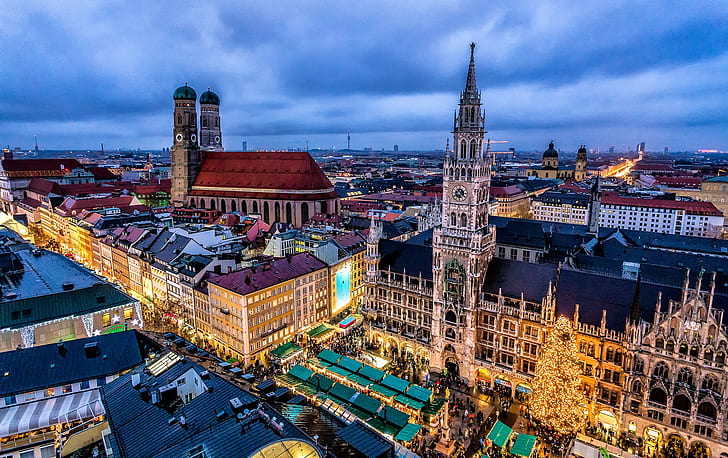
Tall tankards and high-tech cars, edgy art and Lederhosen – Munich is a city where traditional and modern sit side by side like few places on earth. Munich, Bavaria’s capital, is home to centuries-old buildings and numerous museums. The city is known for its annual Oktoberfest celebration and its beer halls, including the famed Hofbräuhaus, founded in 1589. In the Altstadt (Old Town), central Marienplatz square contains landmarks such as Neo-Gothic Neues Rathaus (town hall), with a popular glockenspiel show that chimes and reenacts stories from the 16th century.
Visit: Neues Rathaus, Englischer Garten, Marienplatz, Asam Church and Hofbräuhaus
The Neue Rathaus (New Town Hall) is a magnificent neo-gothic building which architecturally dominates the north of Munich’s Marienplatz.
The "Englischer Garten" (English Garden) is one of the largest urban parks in the world. The layout has undergone constant change for centuries as new buildings and green spaces gets added time and again.
Marienplatz (square) has been at the centre of the city since Munich was founded by Henry the Lion in 1158. It was the point at which all of the new city’s most important streets met.
These days, you can sit in the shadows of the Neues and Altes Rathaus (New and Old Town Halls) and enjoy a relaxing cup of coffee, watching the hustle and bustle around you. It is also the ideal place to start a tour of the shops in the pedestrian zone or Viktualienmarkt. If you want to act like a true native of Munich, arrange to meet up at the Fischbrunnen (fountain) in front of the main entrance to the Neues Rathaus. At the centre of Marienplatz, you will find the Mariensäule (column). On top of the column, a golden statue of the Virgin Mary, the Patrona Bavariae, watches over the city and the state of Bavaria.
The Hofbräuhaus in München is a brewery in Munich, Germany, owned by the Bavarian state government. The Hof (court) comes from the brewery's history as a royal brewery in the Kingdom of Bavaria. The Hofbräuhaus in Munich is one of the most famous bavarian restaurants and breweries in Europe
|
|
| Day 19 |
Exit to India |
NA |
|
Day 19
|
Check out from your accommodation and proceed to catch your flight back to India
|
|


















